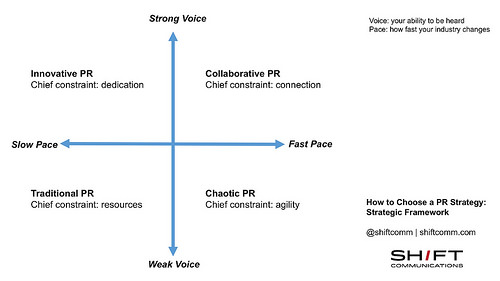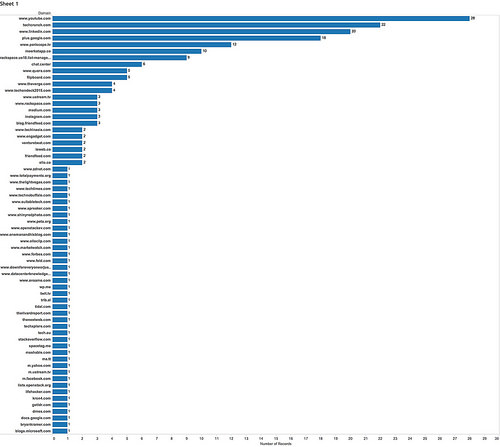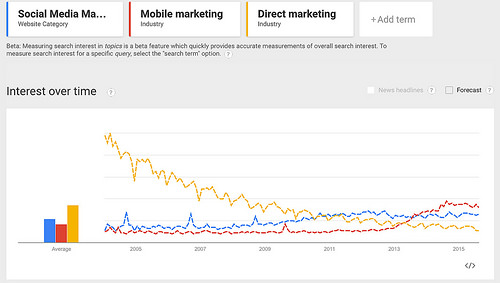Strategy is one of the most overused and misunderstood terms in business. If you ask 100 executives what strategy means, you’ll likely get 150 different responses. In this six-part series, we’ll explore how to pick a PR strategy using clear, measurable criteria and a broader strategic framework. Today, we’ll focus on how to select the right strategy.
Recall that our framework for choosing a PR strategy is based on two dimensions, pace (how fast things change) and voice (how easy it is to be heard):
How do you choose the right PR strategy? Begin by understanding what your limits are, what restrictions you have. In the chart above, we list four chief constraints.
- Are you restricted by resources? These include time, labor, and of course money.
- Are you restricted by agility? Agility is defined by how quickly you can make changes.
- Are you restricted by dedication? This is your resolve to keep going in a given direction for months or even years without great success shown.
- Are you restricted by connection? Is your network less strong than it should be?
Knowing your limitations will give you a sense of which quadrants in the above chart will present the greatest difficulties for your overall PR strategy.
Next, identify your placement on the chart above by defining how easy it is to gain a share of voice and how fast-paced your industry is.
To find out your share of voice, try this simple test. Check out the top 2 or 3 influencers or publications in your area and see what content they post. For instance, here’s a chart showing what tech influencer Robert Scoble has shared recently, sorted by domain. (Links to Facebook and Twitter are not included):
Above, the graph shows that Scoble shares from a few major domains like Techcrunch, LinkedIn, and live streaming video apps most often, but there aren’t a ton of different sources. As a result, if you’re looking for tech coverage, the ability to gain a share of the conversation through him is relatively difficult. If you get in, you can achieve a strong share of voice because there isn’t a great deal of competition. Thus, constraints like dedication (trying to get Scoble to notice your content) and connection (trying to get a hold of Scoble) matter in order to get seen.
Compare this with social and digital marketing influencer Jason Falls:
The graph above, intentionally difficult to see, shows that Falls shares a tremendous amount of content from a very wide variety of sources. This puts any one publication in a relatively weak share of voice; getting Jason Falls to share your content isn’t an impossible task (as long as your content is good), but getting noticed in the pack might be. Constraints like resources (such as adding paid promotion behind one of Jason’s shares) or agility (ensuring that you provide Jason lots of content that’s timely) matter most in order to get seen.
If you’re not sure about the pace of your industry or topic, the easiest way to make that determination is with a service like Google Trends. For example, suppose you’re wondering about the pace of the video streaming market:
This is clearly an ascendant market; the pace is quickening. Thus, if you’re in the video streaming industry, you now know that strategies which favor collaborative PR – fast pace and potentially strong voice through influencers like Robert Scoble – could be your best bet. If you lack connections, however, you’re in a really bad spot, and building those connections should be your first priority, the first tactical steps you take towards a collaborative PR strategy.
Contrast this with some of the digital marketing channels:
Social media marketing and direct marketing (which includes marketing like email marketing) are slowing down. The pace isn’t as fast, whereas mobile marketing is ascendant. If you’re a social media marketer or a digital direct marketer, you probably already know that there isn’t a ton that’s new under the sun. Thus, you have a slowing pace and a weak voice environment. Traditional PR strategies – which will involve a lot of commitment of resources – will be necessary to be heard. You will need influencers like Jason Falls, but you will also need paid media budget, cross channel integration, and lots of time in order to achieve success.
Conclusion
We’ve taken a grand tour through the world of PR strategy, from traditional PR to handling PR in a chaotic environment, from innovation to collaboration. You’re now equipped to analyze and determine the best overall PR strategies for your industry; you have a better feel for what could work and what isn’t going to set you up for success.




